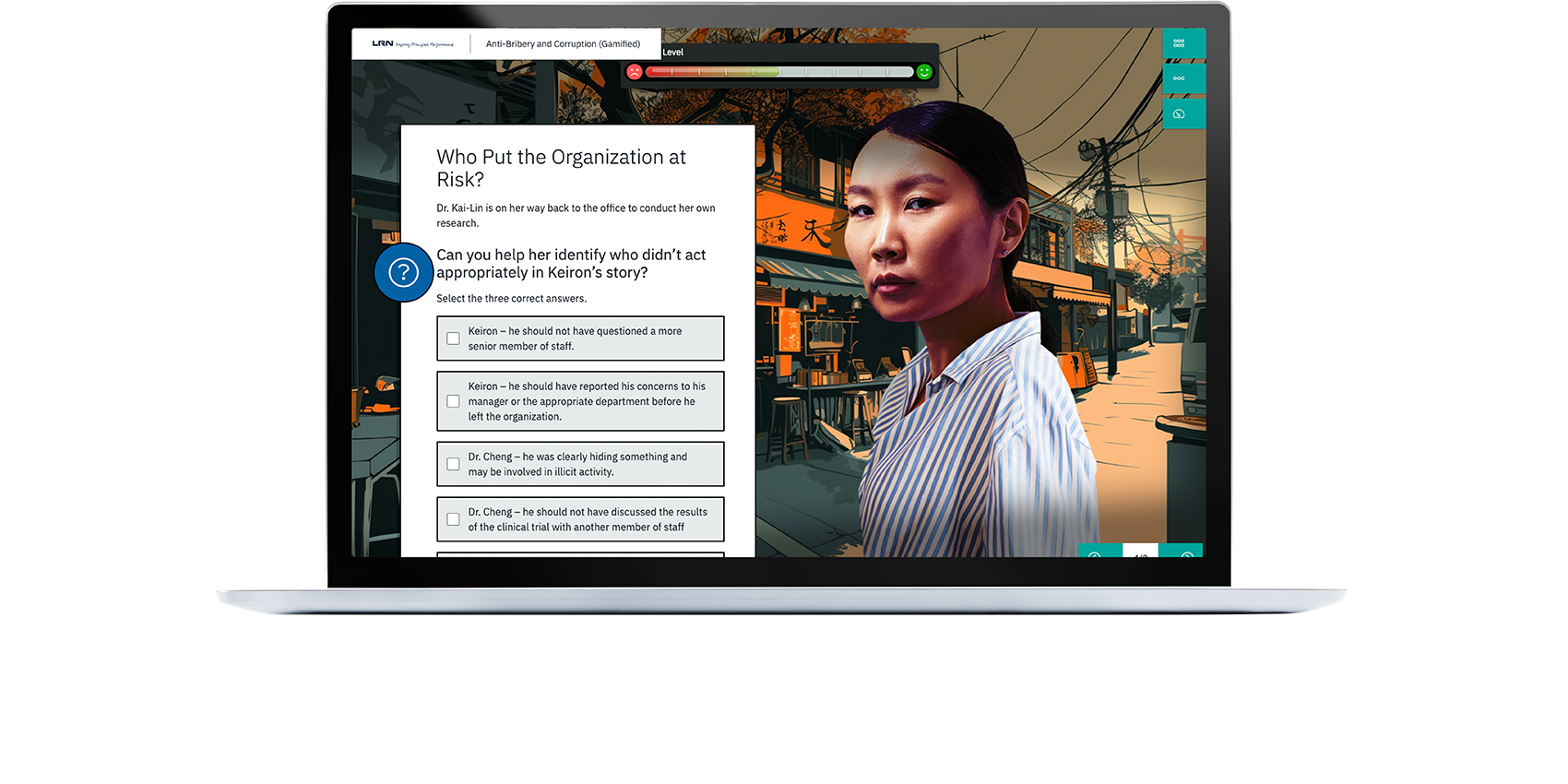Video has become a popular format for delivering ethics and compliance training for employees. When done well, compliance videos can move the needle on strengthening ethical culture and driving behavior change. And they can also win awards.
Earlier this year, LRN secured 10 Telly Awards at the 43rd annual awards program honoring excellence in video and television across all screens. These diversity, inclusion, and workplace culture videos were created as part of larger ethics and compliance training to help employers effectively educate employees and address difficult issues like workplace harassment and discrimination, microaggressions, and reporting misconduct. Some individual pieces even won in multiple categories, an exciting validation of the quality of this type of training format.
So, what exactly does it take to develop award-winning compliance videos for employees? To find out, I spoke with several of the learning designers, graphic designers, and media producers who worked on the following compliance training videos (which you can watch here):
- Operation Brain Strategies is a meaning maker video for The Initiative - Advancing the Blue & Black Partnership. It was a Gold Winner in Non-Broadcast - Social Issues, a Silver Winner in Non-Broadcast - Education & Training, and a Bronze Winner in Non-Broadcast - Health & Safety.
- Microaggressions: Personal Stories, a DEI training video that is part of the LRN Library, is a Telly Awards Gold Winner in Non-Broadcast - Diversity & Inclusion.
- LGBTQ+: Authentic Allyship & Understanding, another DEI training video that is part of the LRN Library, is a Telly Awards Silver Winner in Non-Broadcast - Social Responsibility.
Here are key insights and best practices they shared about how to approach the creative process, stages of production, and learning strategy for an award-winning training video.
The learner experience must be the foundation of your compliance training video
- Your video needs to reinforce whatever the course is trying to teach its learners—in the writing, the imagery, the sound, everything. How does each element help educate someone about the topic? —Ray Vagge, Media Producer
- Training aims to drive behavior change, and you only have so much time with a video. So, make your video as central to the learner as possible. Ask yourself: What action do I want them to take? How can I get them emotionally involved in the story? What experience can this video create that inspires them take action? It should always come back to the learner. —Heather Barlow, Learning Manager
- Sometimes, video seems like the magic bullet for training. People think “We don't want to bore our learners, so we'll just turn everything into video.” But it's important to remember that because video has a lot of power, it should be used strategically. Video can influence people, spur emotion, and communicate really complex ideas. The most important thing is to focus on what you want learners to feel, think, and do after they watch the video. You have to figure out the challenge or issue you want to address and present it to learners in a way that gets them to care about it—whether it’s through scripted or unscripted video, an “explainer” or sharing personal stories. But it has to fit in the flow of the overall learning experience, so that the rest your training course can present the solution. —Kristen Motzer, Learning Director
Cross-functional collaboration is key to creating good corporate compliance videos
- Our media team were real partners in exploring this new approach to training videos, which adopted more of an interview style. Fortunately, most of the training world is moving away from videos that feel overly scripted and cringe-worthy; meaning, using scenarios that wouldn’t really happen or writing dialogue that people wouldn’t realistically say. One of the beautiful things about the democratization of the internet is that everyone can share their own stories; that’s what people want now. Our team recognized this and made a great case for trying it with DEI topics, which can be hard to talk about but really benefit from personal experiences. —Kristen Motzer, Learning Director
- When it comes to video, don’t skimp on pre-production and planning conversations. For the LGBTQ+ and Microaggressions testimonials, we spent a lot of time drafting the interview questions and working with the instructional designer to make sure they tied back to the courses. We also talked about how to deliver the questions to our interviewees, so it’d feel more conversational and put them at ease. For our scripted videos, we talked at length about which types of footage would best elevate the writing rather than distract. These discussions informed so much of our production process. —Ray Vagge, Media Producer
- Be open to receiving input from anyone on the team. We had members of video production make recommendations on the script. We had instructional designers giving feedback on graphic design. When you can see the value that other people bring to the collective team, that's when you can get the most out of your final product. —Heather Barlow, Learning Manager
- The team collaborated at a profound level to create these impactful videos. The final product reflects a deep understanding of the key message and its significance. It was inspiring to be part of this project, a project we believed would make a positive difference and create change. Everyone involved went above and beyond to push these videos to the highest level and the results reflect this understanding and passion, achieved through successful collaboration. —Ann O’Connell, Design Manager
Let your audience and learning strategy guide the writing of your training video
- You want to begin with the end in mind. What is the end goal for your video? For the videos we created for The Initiative, the end goal was to get their audience—police officers—to take a training course on mindfulness. We knew that mindfulness isn't a topic that’s widely talked about or prioritized with first responders. We also knew that The Initiative’s larger mission was to promote community policing and create an “us” mentality instead of "us versus them.” So, using that end goal, we recognized that the topic of mindfulness needed to home in on teaching police officers how to respond to situations instead of react to them. That’s how we came up with the title and script for “Operation Brain Strategies," which approached the topic of mindfulness by diving into the science behind decision-making. —Heather Barlow, Learning Manager
- The hardest part of creating the testimonial videos was writing the interview questions, so it’s crucial to allot more time to that step. You want to write questions that are going to give rich responses and feel relatable to folks. The best questions will even solicit new insights and help people discover new things about themselves, revealing new ways to frame their own experiences. —Kristen Motzer, Learning Director
- When choosing words and tone for your script, start by stepping into the shoes of your audience. With “Operation Brain Strategies,” we knew the script needed to represent the subject matter in a realistic way without trying to bait and switch. It was important that the content speak directly to the learners, who were police officers. To achieve that, we spoke with several police officers and other first responders to better understand how they think about these topics. At every stage of scripting, we asked ourselves how they would perceive this content as someone who experiences bias on a daily basis. —Heather Barlow, Learning Manager
- Significant time and consideration went into creating these videos. I acted as a sound board for our learning manager and media team, determining how the visuals would support the learning material. I contributed graphics to complement the voiceover in “Operation Brain Strategies,” which describes how people react in a state of conflict: heart rate increasing, pupil dilation, clenched jaw. Although the graphic elements were small, they were needed to reinforce the larger message of the training. Details matter. —Ann O’Connell, Design Manager
Trust is paramount to the creative process of any ethics and compliance training video
- Gaining trust from the client upfront is huge. We always strive to demonstrate our expertise in learning design and production, but if the client doesn't understand or trust the creative strategy then the video will suffer. Seeing The Initiative explicitly place their trust in us was crucial to the success of these videos. Trust is important for any project. —Heather Barlow, Learning Manager
- Take your time and trust your gut instinct when selecting stock footage, especially if your training video covers sensitive material. Topic areas like DEI require communicating complex, emotionally charged information. We constantly asked ourselves (and each other) “Does this footage seem phony? Is it capitalizing on real tragedy?” Remember, you’re creating ethics and compliance training; evaluating the ethical impact of the video you use can’t be overlooked. —Ray Vagge, Media Producer
The key takeaway
Video has a lot of power in ethics and compliance training, and that requires a lot of thought, trust, and experimentation. To watch these award-winning compliance videos for employees, click here. You can also learn more about LRN's custom learning work for The Initiative or sample our array of materials (including training videos) to launch a DEI learning program at LRN.com.



